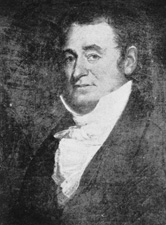James Brown (Senator)
| James Brown | |
|---|---|
 |
|
| United States Minister to France | |
|
In office April 13, 1824 – June 28, 1829 |
|
| Appointed by | James Monroe |
| Preceded by | Albert Gallatin |
| Succeeded by | William Cabell Rives |
|
United States Senator from Louisiana |
|
|
In office February 5, 1813 – March 4, 1817 |
|
| Preceded by | Thomas Posey |
| Succeeded by | William C. C. Claiborne |
|
In office March 4, 1819 – December 10, 1823 |
|
| Preceded by | Eligius Fromentin |
| Succeeded by | Josiah S. Johnston |
| 1st Secretary of State of Kentucky | |
|
In office June 5, 1792 – October 13, 1796 |
|
| Preceded by | New office |
| Succeeded by | Harry Toulmin |
| Personal details | |
| Born |
September 11, 1766 Staunton, Virginia |
| Died | April 7, 1835 (aged 68) Philadelphia, Pennsylvania |
| Political party | Democratic-Republican |
| Spouse(s) | Ann "Nancy" Hart |
| Alma mater |
Washington and Lee University College of William and Mary |
James Brown (September 11, 1766 – April 7, 1835) was a lawyer beginning in Kentucky, U.S. Senator from Louisiana, and Minister to France (1823-1829).
His brother John Brown was a US Senator from Kentucky and active in its gaining statehood. Well-connected among the southern elite, they were also cousins of John Breckinridge, James Breckinridge and Francis Preston. James Brown was brother-in-law to Henry Clay and Nathaniel G. S. Hart, the uncle of James Brown Clay, Henry Clay, Jr., John Morrison Clay, the great uncle of B. Gratz Brown, and the cousin-in-law of Thomas Hart Benton.
Born near Staunton, Virginia, Brown attended Washington College (later Washington and Lee University) in Lexington, Virginia, and the College of William & Mary, Williamsburg, Virginia. He read law, was admitted to the bar, and commenced practice in Frankfort, Kentucky.
Brown commanded a company of sharpshooters in an expedition against the Indians in 1789. His wife was Ann "Nancy" Hart, and her sister of Lucretia married Henry Clay, who became an important statesman from Kentucky.
...
Wikipedia
